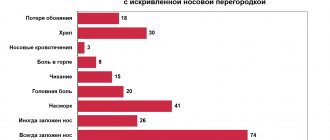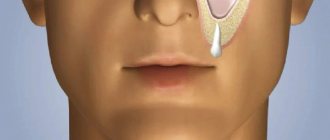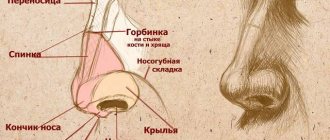Reasons for the development of the disorder
The main reasons for the development of perforation of the nasal septum include:
- Surgical intervention performed by an inexperienced surgeon;
- Nose injuries of various types, frequent mechanical damage, hematomas without treatment;
- Infectious diseases that destroy cartilage, which leads to the formation of a hole in the nasal septum;
- Long-term use of vasoconstrictor drugs;
- Systemic connective tissue diseases;
- Dry atrophic rhinitis;
- Malignant processes in the nasal cavity;
- Use of certain types of drugs.
Also, one of the reasons for the formation of perforation of the nasal septum is the constant exposure to toxic substances on the nasal cavity (harmful production due to non-compliance with safety precautions in the production process).
Causes of perforation:
- trauma caused by the patient himself; often perforation occurs in people who have the habit of picking out crusts from the nose; this is, among other things, a common cause of perforation in children;
- perforations can occur as a complication after surgery on the nasal septum;
- long-term use of vasoconstrictor drops, hormonal drops, narcotic drugs inhaled through the nose;
- autoimmune vasculitis (for example, with Wegener's disease), when, due to inflammation, small vessels are clogged and due to lack of blood supply, the mucous membrane and cartilage tissue in the nose are destroyed.
Symptoms of perforation depend on its shape, size and location. Some perforations may remain asymptomatic for years.
Most common symptoms:
- formation of crusts in the nose,
- nosebleeds,
- recurrent infection of the nasal mucosa,
- whistling when breathing.
Reasons for increasing perforation size:
- constant exposure to an air stream that dries the edges of the hole,
- constant infection with local microflora.
Symptoms of the disease
Minor perforation of the nasal septum is usually asymptomatic. In some cases, the patient notices a whistling sound when inhaling and exhaling through the nose. In most cases, patients note the presence of common symptoms for inflammatory processes in the nasal cavity: dry nose, difficulty breathing through the nose, and in rare cases, nosebleeds.
As the perforation of the septum grows, purulent discharge with an unpleasant odor appears. If any symptoms uncharacteristic of ordinary rhinitis occur, the patient should urgently consult a doctor for a thorough diagnosis.
Symptoms and diagnosis of perforation
A small hole in the nasal septum may not manifest itself for a long time. But against this background, the risk of infection or breathing problems increases. Therefore, the main symptoms of a hole in the nasal septum are the manifestations of the complications that it causes. These include:
- The appearance of a whistling sound when inhaling and exhaling through the nose;
- Nasal congestion and difficulty breathing;
- Feeling of dryness, discomfort, less often – pain in the nasal cavity;
- Bleeding from the nose or purulent discharge, often with a foul odor;
- If the perforation of the nasal septum is large, there will be a noticeable external change in the shape of the nose (for example, a “saddle nose”, when the back of the nose appears to have sunken in).
Only a doctor can diagnose the presence of a hole in the nasal septum after examining the nasal cavity - rhinoscopy . However, in addition to detecting the hole, the doctor needs to conduct additional examinations and tests (complete blood count, test for syphilis, etc.) to exclude the recurrence of the problem.
In our clinic you can undergo surgery to correct the nasal septum. See detailed prices and costs here.
Why is correct diagnosis important?
Perforation of the nasal septum is not a disease. This structural disorder of the nasal septum is in many cases a consequence of a purulent process caused by another disease. Perforation will not disappear and will not heal once the cause of its appearance is eliminated. The perforation itself requires surgery. However, performing an operation without examining and excluding diseases that cause this destructive disorder is unacceptable.
Perforation of the nasal septum is diagnosed during an initial examination by an ENT doctor, who must prescribe a comprehensive examination of the patient to identify the nature of this disorder. The results of the examination will help to correctly prescribe therapy. After the cause of perforation has been completely eliminated, the patient undergoes surgery. The operation is carried out in a clean room using professional washing and disinfection machines lkmed.ru/catalog/ochistka-i-dezinfekciya/
Complications
The most common complication of perforation of the nasal septum is the formation of a pronounced cosmetic defect. The main reason for its development is the lack of timely treatment. The need for surgical intervention increases the risk of hematoma formation, abscess of the nasal septum with subsequent re-perforation. With secondary infection, the likelihood of developing bacterial complications increases: orbital phlegmon, sigmoid sinus thrombosis, meningitis and others. After rhinoplasty, patients experience an increased tendency to infectious diseases of the nasal cavity and paranasal sinuses: chronic rhinitis, sinusitis, frontal sinuses.
Methods for correcting the nasal septum
Perforation of the nasal septum can only be eliminated surgically. Today, plastic surgeons practice several techniques to eliminate perforation, the choice of which depends on the size of the hole.
The Tardi method involves closing the hole with a mucous flap taken under the upper lip and inserted into the formed soft tissue canal. This method closes perforations up to 5 cm in size.
Other methods involve closing smaller perforations up to 2 cm in size (Fairbanks, Friedman methods). During the operation to eliminate perforation, both tissue taken from the patient (autografts) and artificial implants can be used. Minor perforation can be repaired by simple surgical suturing. After surgery, the nasal cavities are packed.
Rehabilitation period and restrictions after surgery
Surgical removal of perforation is an operation that requires the patient to stay in the hospital. The general period of incapacity for work is 10-14 days. The length of hospital stay is determined by the patient’s condition (on average 3-5 days). Tampons are removed the day after surgery.
The rehabilitation period after surgical correction of the nasal septum is characterized by certain limitations:
- A gentle regime without physical activity, significant temperature changes, injuries and mechanical damage to the nose for 1 month after surgery;
- Follow a diet, avoiding eating hot, cold food, alcoholic beverages for 2 weeks after surgery;
- Compliance with the doctor’s recommendations for caring for the operated area (the duration of use of the drugs is determined by the patient’s condition).
Perforation of the nasal septum is a complex structural disorder of the nasal septum, which is a complication after surgery or a consequence of inflammatory processes in the nasal cavity. With perforation, a persistent through hole is formed in the cartilaginous or bone structures of the nose, requiring surgical intervention. In case of perforation, correct diagnosis is necessary to avoid further development of destruction of the nasal septum. Surgical intervention requires the highest qualifications of the surgeon.
Perforation of the nasal septum
Recently, letters from patients with perforation of the nasal septum began to often come to the clinic’s website. Recently, Professor A. S. Lopatin received the following letter for “feedback”: “Hello, Andrei Stanislavovich. My daughter has a “hole” on her nasal septum. She is 15 years old. This problem started about two years ago. A year and a half ago we had surgery with a plastic surgeon. The hole was small. The surgeon straightened the daughter's nasal septum and sewed two pieces of tissue taken from the oral cavity. In general, the operation was successful. But literally after a month the sewn fabric began to come off. for three to four months, under the supervision of a surgeon, we tried to keep her (drops, ointments, etc.). however, nothing helped. For about 8 months, until the New Year 2020, the size of the hole remained the same. However, recently it has begun to increase. Now the size is a little more than half a centimeter. And this has a very difficult impact on her physical and emotional state. I appeal to you as the best, in my opinion, specialist in this field with a request to accept my daughter for examination and further surgery at a time convenient for you. We think that our problem can only be solved surgically. This is my first time contacting a doctor via the Internet and I don’t know what other information should be provided to you for consideration and decision-making. I would be very grateful for any response to my request."
The scientific director of the Otorhinolaryngology Polyclinic, Professor A. S. Lopatin explained the cause of this disease and why so many letters are received on this topic:
- Indeed, the number of patients with perforation of the nasal septum has increased - sometimes three patients come in one day. Previously, this disease was considered extremely rare, and arose mainly due to improperly performed surgery - septoplasty or submucosal resection.
But we are talking about increasing cases of perforation, which occurs independently, and not as a result of operations and injuries. If postoperative perforation most often does not increase over time, then spontaneously occurring perforations usually grow. In this case, the edges of the hole in the nasal septum are themselves ulcerated and covered with bloody crusts. These scabs often come off on their own or are removed by the patient, causing nosebleeds and further growth of the perforation. They increase to their maximum size - until the cartilage of the nasal septum is completely destroyed, which leads to deformation of the nose as in patients with syphilis.
If we talk about the frequency of such perforations, then in previous years, according to American statistics, they were 6 cases per 10 thousand people or 0.06%. However, recently other statistics have appeared, based, in particular, on two publications from Sweden, which give a figure tens of times higher - 1% of the Swedish population has holes in the nasal septum. And when at the international congress in Toulouse I asked the authors of these articles how they explained the increased prevalence of this disease in Sweden, they answered me that this was due to the dry, cold climate of the country.
In more southern European countries, such as France or Italy, doctors believe that cocaine use is the cause of the spontaneous appearance of perforation in the nasal septum. Another cause of the disease may be long-term use of vasoconstrictor nasal drops and sprays, as well as some medications that are used to treat allergic rhinitis and polyps.
According to my observations, based on more than 500 cases of perforation and about 300 operations performed to close it, I suggest that in addition to the known factors - dry cold climate, technological air pollution, long-term use of drugs - a change in the normal microbial composition of the nasal cavity matters a lot. When the usual non-pathogenic bacteria living in the nasal cavity are replaced by aggressive forms of Staphylococcus aureus, the biocenosis of the nasal cavity is disrupted. Our studies show that in patients with non-traumatic perforation, Staphylococcus aureus is present in 92.5% of cases, while in patients with traumatic perforation - only in 16%.
All of the above factors, acting in combination, especially in people with a deviated nasal septum, cause the formation of erosion on the convex part of the deviated septum, then an increasingly deeper ulcer, the increase of which leads to the destruction of the cartilage, and then the mucous membrane of the reverse side of the septum. As a result, a through hole is formed in the partition.
The treatment for this disease is only surgical. This is a plastic surgery, which must necessarily be preceded by a course of local antimicrobial therapy in order to get rid of Staphylococcus aureus. Successful sanitation of the nasal cavity against Staphylococcus aureus increases the percentage of successful operations from 63% to 92% of cases of complete closure of the perforation.
The first symptoms of a newly formed perforation are dryness, crusting in the nose and whistling when breathing, which is characteristic of a newly formed small perforation, and as it grows, the whistling disappears.
To prevent perforation, it is necessary to take care of the nasal cavity, regularly rinse it with an isotonic solution of sea salt (you can use ready-made aerosols in cans from a pharmacy), and have air humidifiers in the bedroom, especially during the heating season. And pick your nose less!
Elimination of pathology
An unresolved hematoma of the nasal septum can cause perforation
Closing the hole in the nasal septum is carried out exclusively by surgery! This operation is part of plastic surgery of the nose; it is aimed at eliminating a defect in the nasal septum, but does not affect the cause of its occurrence.
Before performing the operation, it is necessary to eliminate the causes that provoke the development of pathology, if possible.
Surgical intervention aimed at closing the hole in the nasal septum can be performed in several ways, depending on the size of the defect:
- For defects with a diameter of one to three millimeters, tightening their edges with sutures is used. Closing the hole with a flap of the nasal mucosa can also be used, which is applicable for defects up to five millimeters in diameter;
- starting with a hole diameter of four millimeters, implants are most often used, both selected from the patient himself and artificial. Implants can be sewn in and close the hole in the cartilage or replace it completely, or the hole can be closed only with mucosal implants without eliminating the perforation of the cartilage.
Before surgery, it is important to eliminate the causes that led to perforation
Such an intervention is carried out both under local and general anesthesia, depending on the patient’s health condition and his desire to use one or another method.
The described intervention can be combined, for example, with otoplasty, which in some cases allows for double benefits - correction of the shape of the ears and obtaining a graft for plastic surgery of the nasal septum.










